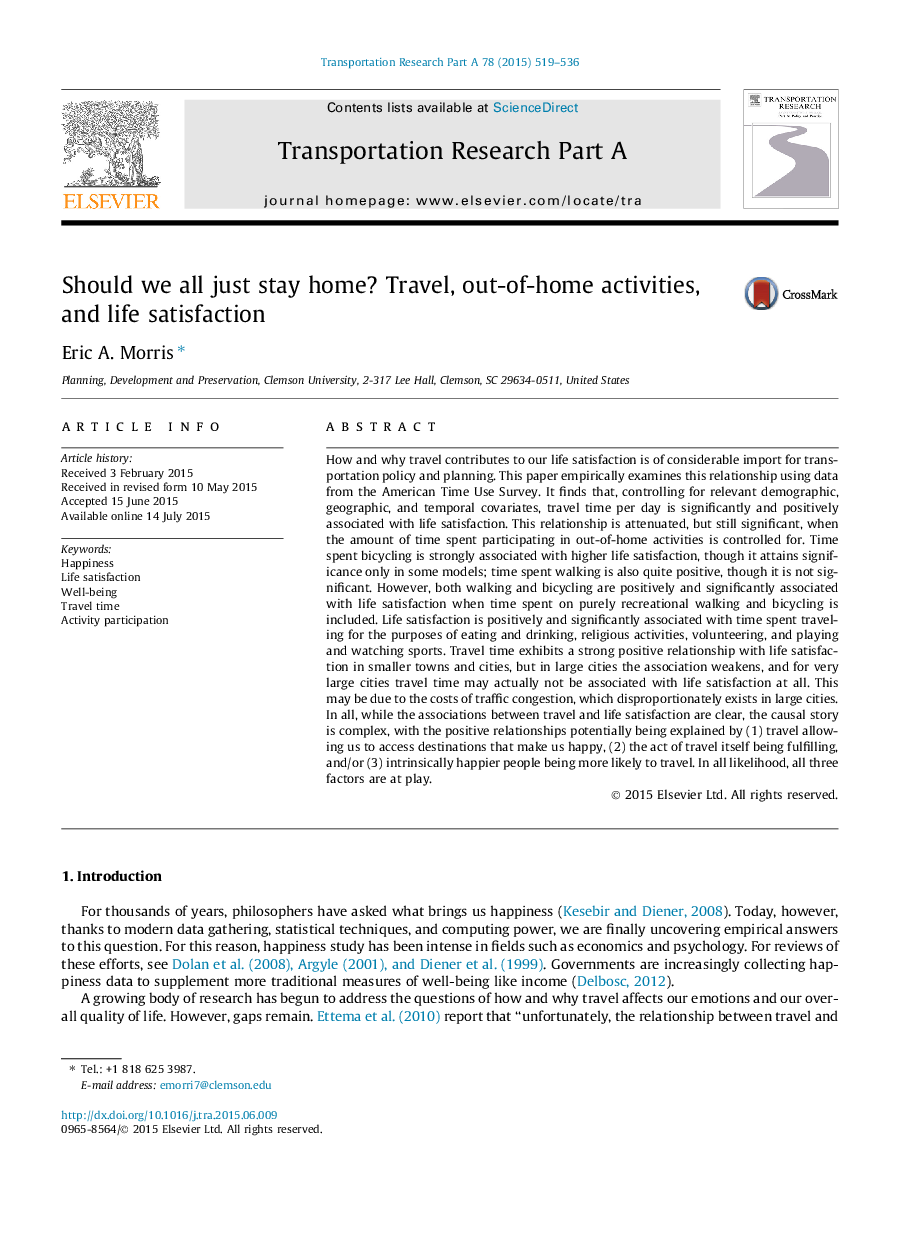| کد مقاله | کد نشریه | سال انتشار | مقاله انگلیسی | نسخه تمام متن |
|---|---|---|---|---|
| 6781290 | 533940 | 2015 | 18 صفحه PDF | دانلود رایگان |
عنوان انگلیسی مقاله ISI
Should we all just stay home? Travel, out-of-home activities, and life satisfaction
ترجمه فارسی عنوان
آیا همه ما فقط باید در خانه باشیم؟ سفر، فعالیت خارج از منزل و رضایت زندگی
دانلود مقاله + سفارش ترجمه
دانلود مقاله ISI انگلیسی
رایگان برای ایرانیان
کلمات کلیدی
خوشبختی رضایت از زندگی، تندرستی، زمان سفر، مشارکت فعال،
ترجمه چکیده
چطور و چرا مسافرت به رضایت زندگی ما کمک می کند از واردات قابل توجه برای سیاست حمل و نقل و برنامه ریزی است. این مقاله تجربی از این رابطه با استفاده از داده های سنجش استفاده از زمان آمریکا استفاده می کند. این یافته می گوید که کنترل زمان های مربوط به جمعیت شناسی، جغرافیایی و زمانی، زمان سفر در روز به طور معناداری و مثبت با رضایت از زندگی مرتبط است. این رابطه کاهش یافته است، اما هنوز هم قابل توجه است، زمانی که مقدار زمان صرف شده در فعالیت های خارج از خانه کنترل شده است. زمان صرف دوچرخه سواری به شدت با رضایت بالاتر از زندگی ارتباط دارد، هرچند در بعضی مدل ها اهمیت دارد؛ زمان صرف راهپیمایی نیز کاملا مثبت است، گرچه این مهم نیست. با این حال، هر دو راه رفتن و دوچرخه سواری با رضایت زندگی مثبت و معنی دار می باشند، زمانی که صرف صرف دوچرخه سواری تفریحی و دوچرخهسواری می شود. رضایتمندی زندگی مثبت و معنی دار با زمان صرف سفر برای اهداف خوردن و نوشیدن، فعالیت های مذهبی، مشارکت داوطلبانه و بازی و تماشای ورزش است. زمان سفر نشان می دهد رابطه مثبت و مثبت با رضایت از زندگی در شهرهای کوچک و کوچک، اما در شهرستانها بزرگ، انجمن کاهش می یابد، و برای شهرهای بسیار بزرگ زمان سفر ممکن است در واقع با رضایت زندگی در ارتباط نیست. این ممکن است به دلیل هزینه های تراکم ترافیکی، که در شهرهای بزرگ بسیار زیاد است، باشد. در کل، در حالی که ارتباط بین رضایت از سفر و زندگی روشن است، داستان علی پیچیده است، با روابط مثبت که به طور بالقوه توسط (1) سفر توضیح داده می شود، به ما اجازه می دهد که به مقصد هایی که ما را خوشحال می کند، دسترسی داشته باشیم، (2) در حال انجام، و / یا (3) ذاتا شادتر مردم بیشتر احتمال سفر. به احتمال زیاد، همه این سه عامل در حال بازی هستند.
موضوعات مرتبط
مهندسی و علوم پایه
سایر رشته های مهندسی
مهندسی عمران و سازه
چکیده انگلیسی
How and why travel contributes to our life satisfaction is of considerable import for transportation policy and planning. This paper empirically examines this relationship using data from the American Time Use Survey. It finds that, controlling for relevant demographic, geographic, and temporal covariates, travel time per day is significantly and positively associated with life satisfaction. This relationship is attenuated, but still significant, when the amount of time spent participating in out-of-home activities is controlled for. Time spent bicycling is strongly associated with higher life satisfaction, though it attains significance only in some models; time spent walking is also quite positive, though it is not significant. However, both walking and bicycling are positively and significantly associated with life satisfaction when time spent on purely recreational walking and bicycling is included. Life satisfaction is positively and significantly associated with time spent traveling for the purposes of eating and drinking, religious activities, volunteering, and playing and watching sports. Travel time exhibits a strong positive relationship with life satisfaction in smaller towns and cities, but in large cities the association weakens, and for very large cities travel time may actually not be associated with life satisfaction at all. This may be due to the costs of traffic congestion, which disproportionately exists in large cities. In all, while the associations between travel and life satisfaction are clear, the causal story is complex, with the positive relationships potentially being explained by (1) travel allowing us to access destinations that make us happy, (2) the act of travel itself being fulfilling, and/or (3) intrinsically happier people being more likely to travel. In all likelihood, all three factors are at play.
ناشر
Database: Elsevier - ScienceDirect (ساینس دایرکت)
Journal: Transportation Research Part A: Policy and Practice - Volume 78, August 2015, Pages 519-536
Journal: Transportation Research Part A: Policy and Practice - Volume 78, August 2015, Pages 519-536
نویسندگان
Eric A. Morris,
